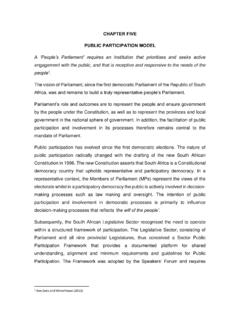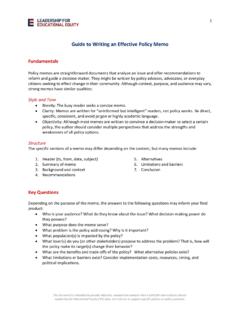Transcription of Volunteerism: Benefits, Incidence, Organizational Models ...
1 Volunteerism: Benefits, Incidence, Organizational Models , and participation in the public Sector Richard D. Young 1 Volunteerism: Benefits, Incidence, Organizational Models , and participation in the public Sector By Richard D. Young Volunteerism: Benefits, Incidence, Organizational Models , and participation in the public Sector is published by the University of South Carolina College of Liberal Arts Institute for public Service and policy Research. The institute provides training, technical assistance, and publications and conducts research designed to enhance the quality and effectiveness of state and local government leadership and management. Contact the institute at: Institute for public Service and policy Research; University of South Carolina; Columbia, SC 29208; (803) 777-8156; Any views construed to be presented in this publication are those of the author and do not necessarily represent or express those of the Institute for public Service and policy Research, the College of Liberal Arts, the University of South Carolina or any other entity of the State of South Carolina.
2 2 Introduction Volunteerism in the United States is neither a new concept nor an uncommon activity. Historically, America has long recognized the importance of a societal responsibility to join in, to give freely of one s time to assist or aid others. This responsibility is frequently iterated in the literature. For example, Alexis de Tocqueville, in 1831, stated in his seminal work, Democracy in America, that the was a nation of joiners that regularly formed groups to meet or accomplish common The past century has seen many notable examples of volunteerism, particularly those associated with federally sponsored programs. For example, the Civilian Conservation Corps (CCC), during the 1930s, worked to plant trees, build bridges and roads, and restore public lands and buildings throughout the United States.
3 In the 1960s, the Peace Corps began work to assist the poorest countries in the world by constructing schools, treating the sick, and assisting in agricultural needs. The Volunteers in Service to America (VISTA) program, initiated during the same decade, undertook assistance to low-income communities across the nation ranging in services from the conservation of natural resources to the cleanup and restoration of urban centers. Today, AmeriCorps, Learn and Serve America, Senior Corps, and USA Freedom Corps are national programs that enlist thousands of volunteers to address virtually every kind of pressing human problem or need. State governments also actively recruit volunteers to help in providing essential services to the citizenry.
4 For instance, volunteers provide various integral emergency services in the wake of natural disasters. Volunteers also lend a helping hand to the state courts and correctional systems. This includes the provision of probation and parole mentors, counselors, teachers and trainers, and foster parents. Adopt-a-highway programs, tax preparation assistance, meals on wheels, hospital care giving, and literally dozens of other state government-sponsored volunteer programs exist. Local governments additionally utilize volunteers. Volunteers provide valuable services to local schools and libraries, parks and recreational programs, senior citizen centers, police, ambulance and firefighting units. Statistically, for example, 80 % of the manpower needs of local fire departments in the are provided for by Non-governmental organizations significantly utilize volunteers as well.
5 Churches, civic groups, neighborhood associations, philanthropic organizations, and a host of other non-profit groups provide a wide-range of volunteer opportunities and services. The American Red Cross, the Natural Resources Defense Council, Catholic Charities USA, Save the Children, Habitat for Humanity, America s Second Harvest, Make A Wish Foundation, and the United Way are some of the larger and better known charitable and volunteer-based private or non-profit groups. In this monograph, volunteerism in America will be briefly examined. First, a working definition of a volunteer will be given and the benefits of volunteerism will be 3highlighted. Second, the magnitude and characteristics of volunteerism in the will be considered in some statistical detail.
6 Third, various Organizational Models of volunteerism, as recognized in the literature, will be discussed in order to better understand the key structures that are fashioned to make use of volunteers. Fourth, some narrative will be devoted to volunteerism as it specifically relates to government organizations. Fifth and finally, the State of Texas will be reviewed as a case study which exhibits the promotion, management, and benefits of using volunteers in the public sector. The Definition and Benefits of Volunteerism According to the Fair Labor Standards Act, a volunteer is: An individual who performs hours of service for a public agency [or organization] for civic, charitable, or humanitarian reasons, without promise, expectation or receipt of compensation for services Similarly, state law in South Carolina defines a volunteer as any person who freely provides goods or services to any agency or instrumentality of government without financial gain.
7 4 Beyond these legal definitions of volunteers, it should be acknowledged that there are, in fact, many variations of the meaning of the term volunteer. For example, Webster s Dictionary simply defines a volunteer as one who enters into or offers oneself for a service of his/her free will. In this sense the volunteer is basically distinguished as one who is not coerced to perform services. Further, while normally voluntary services are performed for which the individual neither expects nor receives compensation, it does not, in many cases, preclude the payment of expenses such as per diem, travel allowances, stipends or living allowances, child care, or educational expenses. AmeriCorps volunteers, by way of example, receive a set living allowance and, upon completion of service, are awarded educational vouchers or payments.
8 Though some remuneration is allowed in many instances, volunteers are thought of typically among the public as persons who voluntarily render services without payment or compensation. This would meet the widely accepted definition of a volunteer as defined by the American Red Cross: A Red Cross volunteer is an individual who, beyond the responsibilities of paid employment, freely and without expectation or receipt of compensation, and for personal, humanitarian, or charitable reasons, contributes time and service to assist the American Red Cross in the accomplishment of its The benefits of voluntarism are widely praised and are several. One study states that greater than 50 % of management in the public sector believe that volunteers provide 4substantial cost-savings and productivity gains to Organizational endeavors, including community goodwill and other intrinsic The Independent Sector, a prestigious coalition of philanthropic and charitable organizations, states that volunteering among many other things adds value to services, promotes social harmony, and creates public More specifically, what are the many benefits of volunteerism?
9 First, the literature indicates plainly that volunteers provide a real economic cost savings. In one study of local governments, it was found that 91 % of volunteer supervisors felt that volunteers permitted local governments to do considerably more without expense or undue Second, volunteerism is recognized generally speaking to be an effective way to interject public participation into non-profit or governmental operations and decision-making processes. It is believed that volunteers can see and understand firsthand, through their various voluntary experiences, that public interests and needs are indeed being seriously and competently pursued and, where possible, successfully met. The literature, in many cases, suggests that volunteers improve citizenship and serve as an effective conduit to educate individuals outside philanthropic and governmental circles as to the merits of public service.
10 In addition to these two main benefits of volunteerism, Brundy (1995) identifies other benefits commonly associated with the use of volunteers in the public sector. These include: Volunteers add to the quality and capacity of programmatic services. Volunteers provide enthusiasm, extra resources and, many times, much needed skills. Volunteers supplement the normal workforce during times of crisis and especially when workload demands peak. Volunteers, who are trained and experienced, provide a ready pool of applicants for employment. Volunteers often provide services outside the normal purview of government employees, such as fund raising and Volunteerism in the United States Studies indicate the United States is the most advanced country in philanthropy in two important respects the percentage of income or gross domestic product (GDP) allotted to charities and the average number of hours devoted to Various reasons account for this phenomenon.







